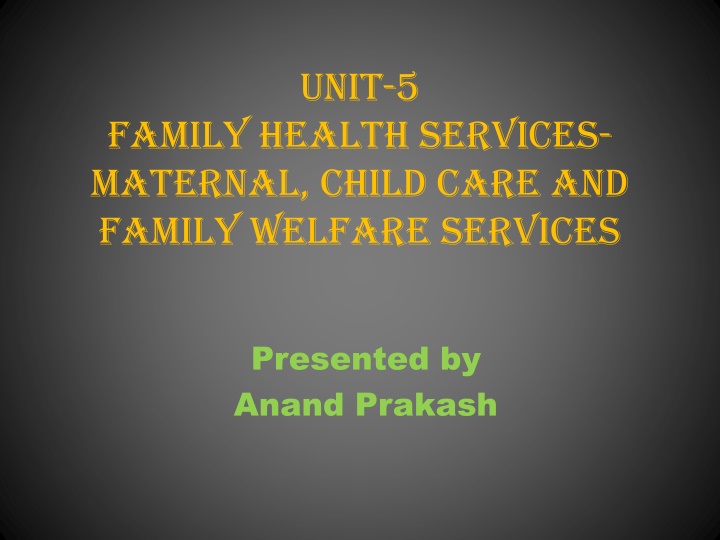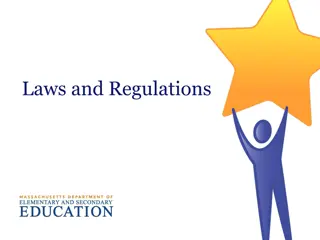
Maternal and Child Health Services: Priorities and Objectives
Discover the significance of maternal and child health services in community health programs, focusing on promoting, preventing, and rehabilitating care for mothers and children. Learn about the goals, objectives, and common health problems addressed in these essential services.
Download Presentation

Please find below an Image/Link to download the presentation.
The content on the website is provided AS IS for your information and personal use only. It may not be sold, licensed, or shared on other websites without obtaining consent from the author. If you encounter any issues during the download, it is possible that the publisher has removed the file from their server.
You are allowed to download the files provided on this website for personal or commercial use, subject to the condition that they are used lawfully. All files are the property of their respective owners.
The content on the website is provided AS IS for your information and personal use only. It may not be sold, licensed, or shared on other websites without obtaining consent from the author.
E N D
Presentation Transcript
Unit-5 family health services- maternal, child care and family welfare services Presented by Anand Prakash
MATERNAL AND CHILDREN HEALTH Maternal and child services are the foremost priorities of community health programmes. According to Indian culture mother is the foundation of the family and children are the future of the country.
DEFINITION According to WHO Maternal and child health services can be defined as promoting, preventing, therapeutic or rehabilitation facility or care for the mother and child.
OBJECTIVE OF MCH To reduce maternal and childhood morbidity rate. Promoting satisfying and safe sex life. Regulate fertility Child survival Promote and protect health of mothers. To promote reproductive health. Ensure birth of healthy child. Promote health G & D.
GOALS To ensure the birth of a healthy infant to every expectant mother. To promote the healthy growth and development of children. To identify health problem in mother and children. To prevent malnutrition in mothers and children.
Conti.. To promote family planning services. To prevent communicable and non-communicable diseases in mother and children. To educate the mother on improvement of their own and their children health.
MATERNAL HEALTH PROBLEMS I. Nutritional problems Malnutrition Nutritional anemia II. Infection problems Reproductive tract infections(RTIs)/ sexually transmitted infection (STI) Infection in general III. Disturbances and mensturation IV. Abortions V. Complications of deliveries
MATERNAL AND CHILD HEALTH SERVICES Prenatal/antenatal care services Intranatal care services Postnatal care services Under five child health services
SOCIAL AND ENVIRONMENTAL FACTORS 1. Age of marriage 2. Age of child bearing 3. Child spacing 4. Family size 5. Level of education 6. Role of women in society 7. Economic status
Common causes of maternal deaths in India complication of abortion 8% hypertensive disorder 5% obstructed labour 5% other disorder 34% sepsis 11% hemorrage 37%
Antenatal services Antenatal care: The care of the women during pregnancy. Aim: The primary aim of antenatal care is to achieve at the end of a pregnancy a healthy mother and a healthy baby.
OBJECTIVE To promote protect and maintain the health of the mother during pregnancy. To detect: high risk case and special attention. To foresee complication and prevent them. To reduce anxiety and dread associated with delivery.
Conti.. To teach the mother elements of child care, nutrition, personal hygiene and environmental sanitation. To sensitize the mother to need for family planning.
ANTENATAL SERVICES A. MINIMUM OF 3 VISIT COVERIING THE ENTIRE PERIOD OF PREGNANCY SHOULD BE: 1stvisit at 20thweeks 2ndvisit at 39thweeks 3rdvisit at 36thweeks
PREVENTIVE SERVICES FOR MOTHERS(BEFORE DELIVERY) a) THE FIRST VISIT: - Health history - Physical examination - Laboratory examination b) ON SUBSEQUENT VISITS: - Physical examination - Laboratory tests - Iron and folic acid supplementation
Conti.. Immunization against tetanus. Instruction on nutrition, family planning, self care, delivery and parenthood. Home visiting by a female health worker Referral services Risk approach Maintenance of records:
CONTI Home visit: is back bone of MCH services. Home visit by the health worker female or public health nurses.
INTRANATAL SERVICES INTRANATAL SERVICES Child birth is a normal physiological process, but complication may arise, septicemia may arise result from unskilled and septic manipulations, and tetanus neonatarum from the use of unsterile instrument. The emphasis on the cleanliness. It entails- Clean hand and fingernails Clean surface for delivery Clean cutting and care of cord
OBJECTIVE OBJECTIVE To provide through asepsis. To prevent injury to baby and mother To prevent complications To provide care to the baby
INTRANATAL CARE INTRANATAL CARE Domiciliary care: Institutional care:
1. DOMICILLARY CARE Mother with normal obstetric history may be advised to have their confinement in their homes, provided the home condition are satisfactory. In such cases the delivery may be conducted by the health workers female or trained dai in knows as domiciliary midwifery services
2. INSTITUTIONAL CARE: At about 1 % of delivery tend to be abnormal, requiring the services of a doctor institutional care is recommended for all high risk cases and where home conditions are unsuitable.
POST NATAL SERVICES Care of the mother (and the new born) after delivery is known as post-natal care.
OBJECTIVES OBJECTIVES To prevent complication of the postnatal period To provide care for the rapid restoration of the mother to optimum health. To check adequacy of breast feeding To provide family planning services To provide basic mother/family To provide care to mother and baby health education to
POST NATAL SERVICES Postnatal examination Hb exmination during postnatal visit Teaching postnatal exercises Family planning services Health education
Child health serviecs
OBJECTIVE Decreasing child death and infant mortality rate. Complete protection of child Nutritious diet to children Overall growth of children Preserve and promote health of under five children Increasing health level of children
services services Immunization Breast feeding growth and development Personal hygiene Detection of health problems & treatment
Child clinics Child clinics Under five clinics Child guidance clinics
Under five clinic Aims and activities Preventive care Growth monitoring Care in illness
Child guidance clinic Child guidance clinic For children suffering from abnormal behavior or psychological problem Psychiatrists, community health nurses and other auxiliary workers services in these clinics
NEONATAL CARE EARLY NEONATAL CARE: The first week of the life is most crucial period in infancy. OBJECTIVE: 1. Establish & maintenance of cardio-respiratory function 2. Maintenance of body temperature 3. Avoidance of infection 4. Early detection and treatment of congenital and acquired disorders.
NEONATAL CARE IMMEDIATE CARE: 1. Clearing the airway: to help to establish breathing, the airway should be cleared mucus and other secretions.



